


Sometimes it seems our whole society is looking at love back to front. We look at why ‘I Don’t’ should come before ‘I Do.’


JohnHughes
“That of a friendly and efficient company, trading with integrity and determined to give its customers the very best of service.”
# 26 November2006FreeCopy 49 Shepperton Road, (Just over the causeway), Victoria Park. Phone 9334 3333 DL 6061
Success through customer service Company Philosophy
REIDY looks at the culture of life and love:
Stevens, the growing global abstinence movements, the couple who waited.
7
flicks
and soon to be seen movies which every child will love and which families can enjoy
6 disccovery
SPECIAL REPORT MARK
Rugby League star Jason
Page
Great
Recent
Page
The real meaning of LOVE
Also in this edition...
Sofia Rodriguez Urrutia-Shu to have a memorial Chapel built at Mater Christi
Page 2
American Churches beat Australian Sylvia Defendi examines why more American teens believe in God
Page 5
The Committee for Family and for Life Discovery brings the most up-to-date new of the activities of the committee
Page 8-10
The truth about the pill Gundrun Schultz examines the medical risks associated with the pill
Page 12
A dying breed Catholic obstetricians are disappearing in the face of demand to perform abortions
Page 13
Discovery
Catholic magazine for families
EDITOR PETER ROSENGREN Letters to: cathrec@iinet.net.au
JOURNALISTS SYLVIA DEFENDI sdefendi@iinet.net.au
MARK REIDY reidyrec@iinet.net.au
OFFICEMANAGER LINDA JOLIFFE - ACCOUNTS recaccounts@therecord.com.au
KATHI HOROBIN - ADMINISTRATION administration@therecord.com.au inc. sales/subscriptions
Contents
November 2006 - Highlights


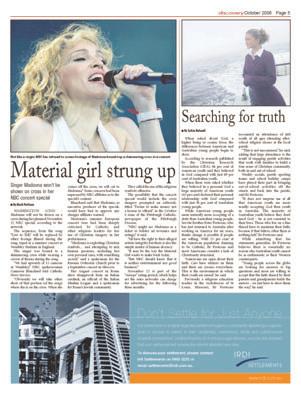

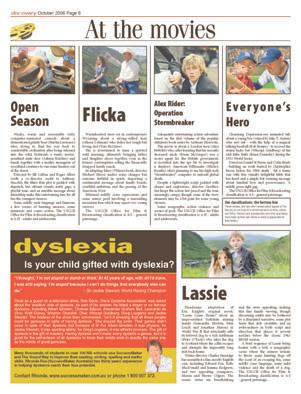

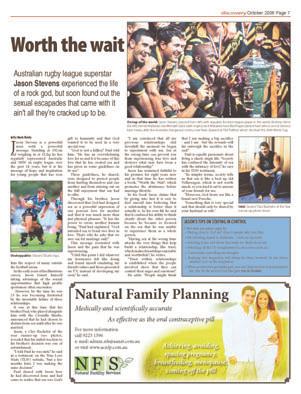

PRODUCTIONMANAGER TERENCE BOYLEN production@therecord.com.au
587 Newcastle St, Leederville
Post: PO Box 75, Leederville, WA 6902
Tel: (08) 9227 7080
Fax: (08) 9227 7087

Page 4
Halloween feature
What is halloween? From where did it come? And what does it mean for different cultures? We examine this occassion, both holy and sometimes unwholesome.
Page 5
Madonna's cross with NBC
NBC may not be televising Madonna's controversial theatrics during her performance of Live to Tell in November.
Page 6
What's at the movies
Discovery looks at what's coming out in the cinemas and let you know what's hot, and what is not.
Page 7
Rugby league's Jason Stevens
Jason Stevens, has been a league man for 14 years, but his life has seen harder battles than that.

Page 14
The change in women's fashion
Women can be both their natural size and happy - it's a message that's starting to spread.
discovery November 2006 Page 2
Small steps for Sofia’s family
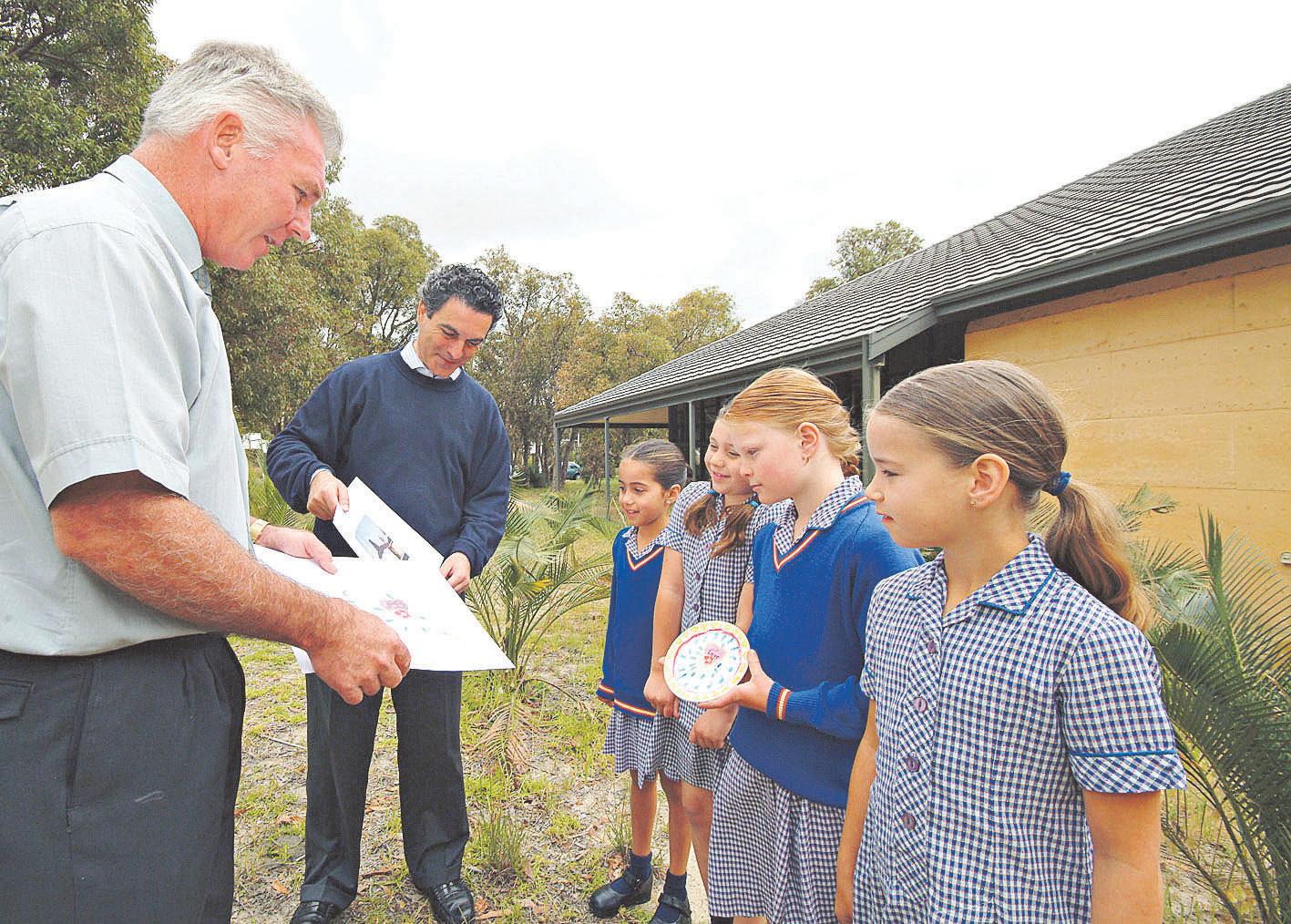 ■ By Sylvia Defendi
■ By Sylvia Defendi
The grief brought on by the horrific murder of 8-year-old Sofia Rodriguez Urrutia-Shu has not ended for her family and those who knew her.
However, the proposed erection of a Sofia Memorial Chapel of the Innocents has the Mater Christi community confident that the young girl’s short life will never be forgotten.
Concept plans for the memorial chapel display a space where all those who have lost a loved one can mourn the passing and most importantly celebrate a union with God, Mater Christi Principal Greg Stinton.
The $150,000 project has been in the making since the Yangebup Catholic community came to grips with the loss of young Sofia,
who was brutally murdered in Livingstone Shopping Centre in June. Eight marble pillars surround the proposed chapel, representing each year of Sofia’s life spent among her loved ones.
The ninth pillar, which serves as an entrance, is damaged, just as her life was, and spires to the sky to signify her union with God, explained Mater Christi parish priest Fr Bryan Rosling. Thirty panes of glass line the inside, representing the year 3 students she left behind.
Artwork by Sofia and messages from those who mourn her will also be included in the construction.
“As these are only concept drawings, there are many things that are still to be discussed and finalised. Over all, however we are very pleased with what has been submitted and look forward to
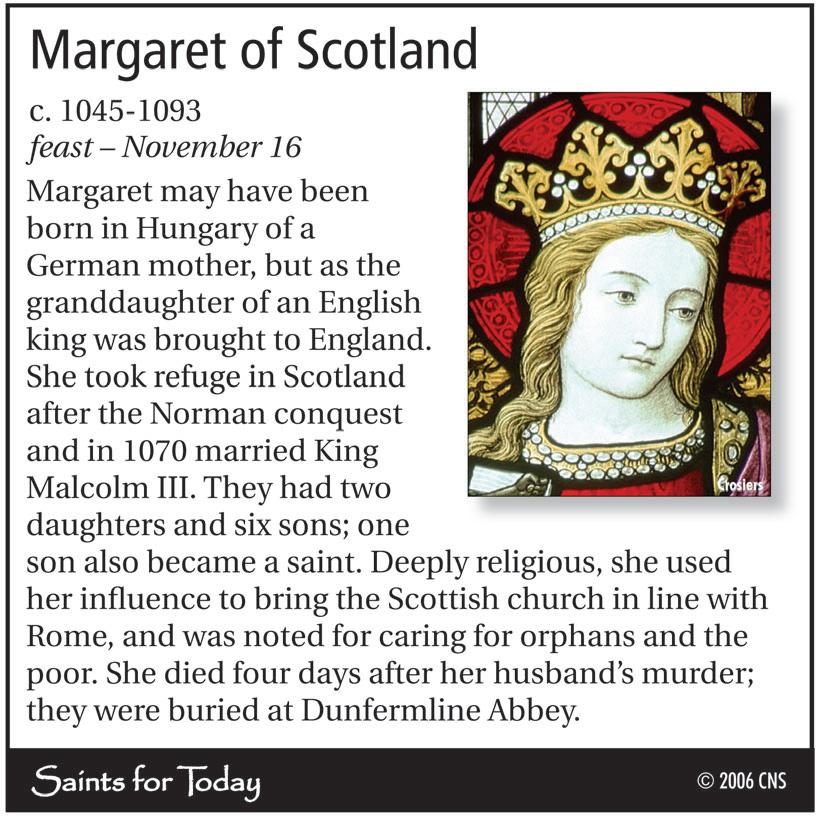

liturgies and have dual access points, one of which will be through the Church.
Mr Stinton hopes the chapel will help the healing process for Sofia’s family, as well as students, staff, parents and friends who mourn her absence or indeed that of any child who has passed.
providing a place for the community to pray for their loved ones and remember Sofia,” Fr Rosling told discovery Auxiliary Bishop Donald Sproxton, who examined the plans and proposed site early last week, was also pleased with the project. Located between the Church and the Catholic primary school Sofia attended, the memorial chapel will cater for children’s masses and
Sofia’s father, Gabriel Rodriguez Urrutia-Shu, told discovery that the faith of his family had been reignited since Sofia’s passing.
“We hope that this chapel will serve as a place where life can be celebrated as well as remembered, and where others can rekindle the fire of their faith after such painful loss,” he said.
While funds are currently scarce, it is planned for the Chapel to be dedicated on Sunday June 24, just two days before the first anniversary
of Sofia’s death. “The cost of building at this time is beyond the parish’s capacity and we are appealing to all within the community who might like to donate towards the creation of this chapel,” he said.
Jean-Mic Perrine of Perrine Architecture has donated his services and his initial concept drawings can be viewed in person at the Mater Christi Church or on Sofia’s website: www.mcps.wa.edu. au/home/sofia.
To assist in building this memorial, contact Sister Emmanuel at Mater Christi Primary School in Yangebup, on: (08) 9417 5756. Funds can also be forwarded to the Sofia Memorial Fund, care of Sr Emmanuel, Mater Christi Catholic Primary School, PO Box 3077, Success, WA, 6964.
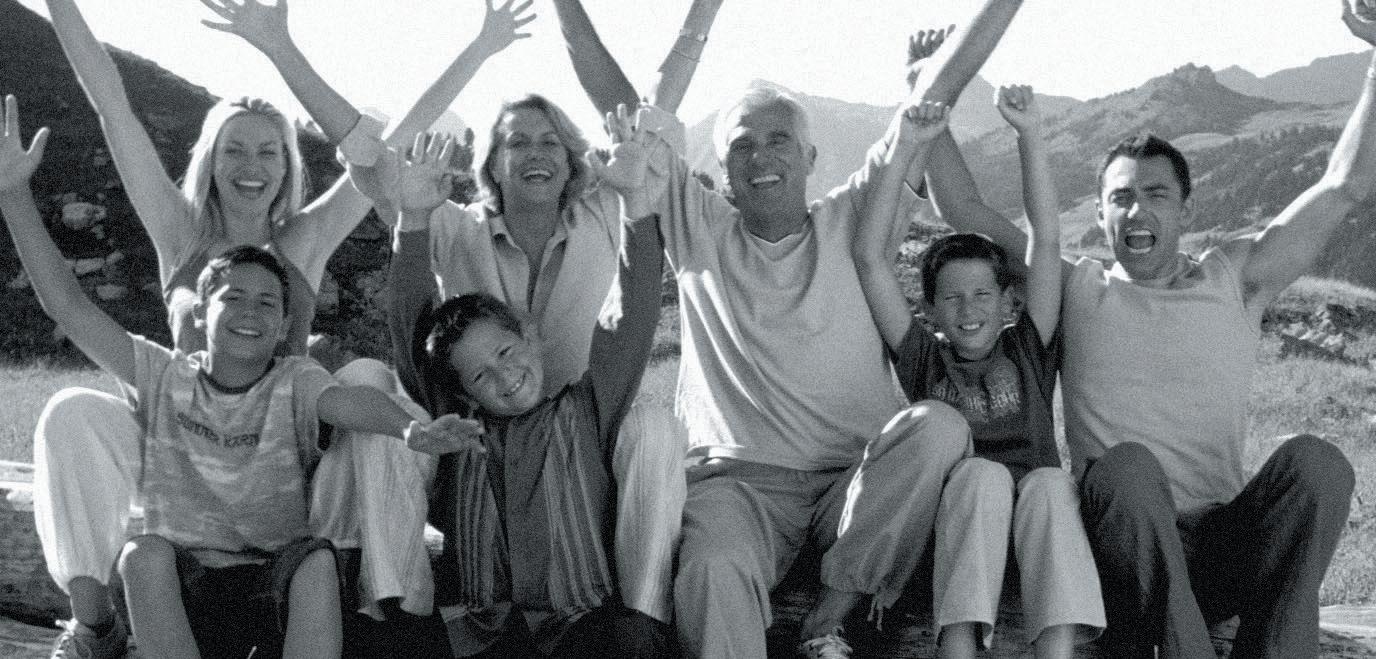
discovery November 2006 Page 3 This insurance product is issued by Catholic Church Insurances Limited ABN 76 000 005 210 AFSL 235415. The Product Disclosure Statement is available from our website or by phoning us. You should read and consider the Product Disclosure Statement before deciding to buy or renew this insurance product. HBT/CCI017/145x157 What an insurance company should be about. Community. While you can trust Catholic Church Insurances to look after your home and your family, it’s our relationship with the community that makes us unique. If you’re looking for a genuinely different kind of insurance company, one that cares for you and shares its profits with the community, you’ve found it. Call us today for an obligation free Building and Contents Insurance quote and affordable Personal Accident Insurance. 1300 655 003 www.ccinsurances.com.au
Approval: Mater Christi principal Greg Stinton and Gabriel Rodriguez Urrutia-Shu, Sofia’s father, reveal the plans to Sharni Lethorn, Jade Wilson, Natalia Ceceres and Georgia Buktenica, Sofia’s best friend.
Photo: Phil Bayne
First steps: Digital concept plans display the future chapel.
Halloween- holy or unwholesome
■ By Sylvia Defendi
Stories of beheaded animals in graveyards seem more like urban myth than reality - a story told to scare children on upcoming Halloween night. But just how much is fiction? Was Halloween always intended to be celebrated in such a destructive way and what implications does it have for our Christian faith?
Brisbane’s Sunday Mail certainly dived into blood and gore as it reported a planned Satanist gathering for this year’s Halloween
that began with the beheading of a goat on Friday October 13.
Destructive rituals, ghosts, vampires and zombies are all somewhat associated with the present celebration of Halloween, yet the origins of this day, while unclear, were not always intended to celebrate death and destruction.
Celebrations occurring around October 31 are documented as originating from Celtic Ireland – 5th Century BC. Samhain, as it was called, celebrated the end of summer and the harvest period with a pastoral and agricultural fire

festival. Traditionally, Samhain was time to take stock of herds and grain supplies, and decide which animals would need to be slaughtered in order to survive the winter.
It was commonly thought, during this period, that Samhain was when the dead revisited the mortal world. Consequently large communal bonfires would be lit to ward off evil spirits.
As the influence of Christianity spread into Celtic regions in the 7th century Pope Boniface IV introduced All Saints Day, a time to honour those who had passed into eternity with God, to replace the old pagan festival of the dead.
For Christians, this became an opportunity to remember all those who had passed into the next life - recognised and unrecognised saints. October 31 thus became All Hallows’ Eve (‘hallow’ meaning saint), which gave rise to the word Halloween.
Pagan festivals warding off evil spirits and the celebration of death as a painful, haunting and evil occurrence were superseded by the Christian celebration of a life that did not end in death, but rather transitioned into a life lived in the presence of God and

all those who had passed into His glory. All Saints and All Souls Days, which are celebrated annually on November 1 and 2, provide Christians with an opportunity to reflect on the inevitability of death, a new life in eternity and the unique communion each Catholic has with those who have passed before them into eternity with God.
The once strong link between All Hallows Eve and All Saints Day, brought on by Pope Boniface IV, has dissolved. This could be the result of reinterpretation, which has seen a once-Christian celebration of life forging a strong association with those who celebrate its destruction.
And while such celebrations of
death do occasionally manifest themselves in graveyards with the destruction of animals, the celebration of Halloween has largely resigned itself to trick-or-treating by the children of America. All Saints and All Souls Day, on the other hand, continue to strongly influence the Christian world, prompting the faithful to remember those who have passed, those who are still on their way to Heaven and the inevitable transition into the next life awaiting all.
Features from a special All Saints and All Souls Day edition of The Record explore these feast days in detail and can be found on The Record website: http://thecatholicrecord.org.
Superstition abounds in Halloween traditions from around the world
Ireland – Barnbrack, which is a fruit bread is eaten by members of a family with a piece of rag, a coin and a ring baked within. If you get the rag then your financial future is doubtful. If you get the coin then you can look forward to a prosperous year. Getting the ring is a sure sign of impending romance or continued happiness.

USA - Salem, Massachusetts sees a great deal of tourism surrounding the Salem witch trials. Keene, New Hampshire, hosts the annual Pumpkin Fest each October which previously held the record for most lit jack-o’-lanterns at one time and place. New York City hosts the United States’ largest Halloween celebration, The Village Halloween Parade, attracting over two million spectators and participants as well as roughly four million television viewers each year.
Austria - People will leave bread, water and a lit lamp on the

table before retiring on Halloween night to welcome dead souls back to earth on a night, which is considered to be brimming with strong cosmic energies.
Czechoslovakia - Chairs are placed by the fireside on Halloween night for each living family member and one for each family member’s spirit.
Hong Kong - Known as “Yue Lan” (Festival of the Hungry Ghosts) people burn pictures of fruit or money, believing these images would reach the spirit world and bring comfort to the ghosts.
Mexico, Latin America and Spain - Often, a live person is placed inside a coffin which is then paraded through the streets while vendors toss fruit, flowers and candies into the casket
Where did Trick-or-Treating originate?
The custom of trick-or-treating resembles the European custom called souling.
On November 2, All Souls’ Day, beggars would walk from village to village begging for “soul cakes” — square pieces of bread with currants.
Christians would promise to say prayers on behalf of dead relatives helping the soul’s passage to heaven.
discovery November 2006 Page 4 Longing for a baby? We can help you identify your most fertile time. SIMPLY NATURALLY EFFECTIVELY Contact Billings WA: 0409 119 532 Free call State Wide 1800 819 841 www.woomb.org Supported by the Commonwealth Department of Health and Ageing and administered by Australian Catholic Bishops’ Conference.

Material girl strung up
Singer Madonna won’t be shown on cross in her NBC concert special
■ By Mark Pattison
WASHINGTON (CNS)Madonna will not be shown on a cross during her planned November 22 NBC special, according to the network.
The sequence, from the song “Live to Tell,” will be replaced by other footage filmed during the song, taped at a summer concert at Wembley Stadium in England.
The singer was bound to a shimmering cross while wearing a crown of thorns during the song.
“We had upwards of 15 cameras at Wembley,” NBC spokeswoman Cameron Blanchard told Catholic News Service.
“Obviously we will take other shots of that portion (of the song) where she is on the cross. When she

comes off the cross, we will cut to Madonna.” Some concern had been expressed by NBC affiliates as to the special’s content.
Blanchard said that Madonna, as executive producer of the special, would have had to approve any changes affiliates wanted.
Madonna’s summer European concert tour had been sharply criticised by Catholic and other religious leaders for her use of Christian imagery in her performance.
“Madonna is exploiting Christian symbols… and attempting to mix human passions, including her own personal ones, with something sacred,” said a spokesman for the Russian Orthodox Church prior to a September concert in Moscow.
Her August concert in Rome drew disapproval from an Italian cardinal, an official of the Italian Muslim League and a spokesman for Rome’s Jewish community.

They called the use of the religious symbols offensive.
The possibility that the concert special would include the cross imagery prompted an editorial, titled “Desire to make money not a licence to offend,” in the October 6 issue of the Pittsburgh Catholic, newspaper of the Pittsburgh Diocese.
“NBC might see Madonna as a ticket to bolster ad revenues and ratings,” it said.
“All have the right to their alleged artistic integrity, but there is also the simple matter of human decency.
“It may be the way the Material Girl wants to make a buck today.
“But NBC should know that it is neither entertainment nor good business.”
November 22 is part of the “sweeps” rating period, which helps set the rates networks can charge for advertising for the following three months.

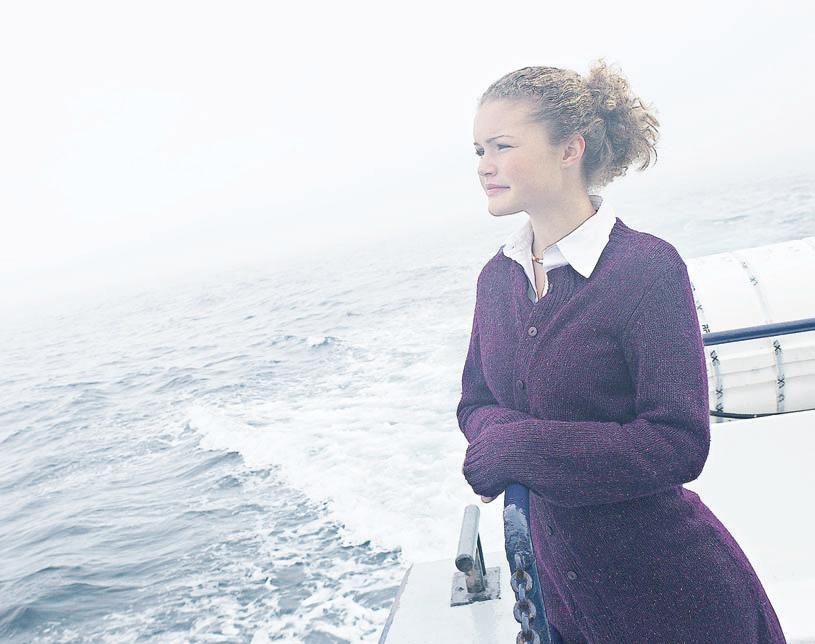
Searching for truth
■ By Sylvia Defendi
When asked about God, a higher being or cosmic force, the differences between American and Australian young people begin to show.
According to research published by the Christian Research Association (CRA), 84 per cent of American youth said they believed in God compared with just 49 per cent of Australian youth.
When these were asked whether they believed in a personal God a large majority of American youth (65 per cent) declared their personal relationship with God compared with just 38 per cent of Australian young people.
While American young people seem naturally more accepting of a deity than Australian young people, Servite Brother Peter Porteous, who has just returned to Australia after working in America for six years, thinks change is possible if people are willing. With 25 per cent of the American population claiming to be Catholic, Br Porteous said most Americans consider a lack of Christianity abnormal.
“Americans are open about their faith. Cars have stickers on them and there are crosses everywhere. This is the environment in which their youth are raised,” he said.
Previously a religious education teacher in the Archdiocese of St Louis, Missouri, Br Porteous
recounted an attendance of 440 youth of all ages attending afterschool religion classes at the local parish.
“This is not uncommon,” he said, adding that large attendance is the result of engaging parish activities that work with families to build a true sense of Christian community, both in and out of school.
Weekly socials, parish sporting teams and school holiday camps have played their part in bringing out-of-school activities off the streets and back into the parish, said Br Porteous.
“It does not surprise me at all that American youth are more readily accepting God than youth in Australia. The majority of Australian youth believe they don’t need God – he is not essential to their lives. Those who live on a fine thread have to maintain their faith, because if that falters, often there is nothing left,” Br Porteous said.
While admitting that his statements generalise, Br Porteous believes there is essentially no reason why Australian youth cannot be as enthusiastic as their Western counterparts.
“Young people across the globe are looking for answers to big questions and most are willing to accept that the faith shared by their parents and grandparents holds the answer – we just have to show them the way,” he said.
discovery November 2006 Page 5 Don’t Settle for Just Anyone Irdi Settlements is a highly regarded settlement agency consistently delivering a superior level of service to clients in their residential, commercial, strata and subdivisional property transactions. Underpinned by an in-house Legal division, you can rest assured that your settlement will receive the utmost attention and care. To discuss your settlement, please contact Irdi Settlements on 9443 5233 or email settlements@irdi.com.au. SETTLEMENTS IRDI www.irdi.com.au
Worth showing: NBC has refused to screen footage of Madonna bound atop a shimmering cross in a concert.







At the movies
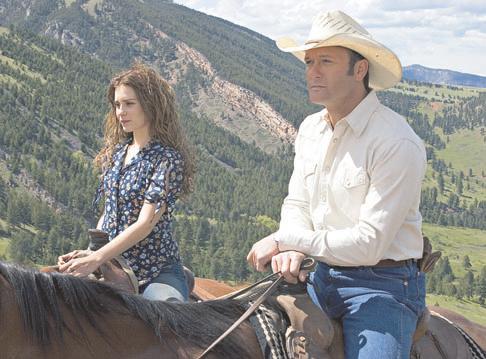


Alex Rider: Operation Stormbreaker
Wacky, warm and reasonably witty computer-animated comedy about a domesticated grizzly bear (Martin Lawrence) who, trying to find his way back to comfortable civilization after being released into the wild, befriends a runty, motormouthed mule deer (Ashton Kutcher) and bands together with a motley menagerie of woodland creatures to run some hunters out of the forest.
Directed by Jill Culton and Roger Allers (with a co-director credit to Anthony Stacchi), the film’s thin plot is padded with slapstick, but vibrant visuals, nutty gags, a playful tone, and an amiable message about friendship make this entertaining fare for all but the youngest viewers.
Some mildly rude language and humour, a few scenes of hunting menace, some innuendo and comic action. The USCCB Office for Film & Broadcasting classification is A-II - adults and adolescents.
Warmhearted story set in contemporary Wyoming about a strong-willed teen (Alison Lohman) who defies her tough but loving dad (Tim McGraw)
She is determined to tame a spirited wild mustang, ultimately bringing father and daughter closer together, even as the former contemplates selling the financially strapped family ranch.
In adapting Mary O’Hara’s book, director Michael Mayer makes some changes but remains faithful in spirit, imparting a sentimental message about family bonds, youthful ambition, and the passing of the American West.
Minimal mildly crass expressions and some minor peril involving a marauding mountain lion which may upset very young viewers.
The USCCB Office for Film & Broadcasting classification is A-I - general patronage.
Adequately entertaining action adventure based on the first volume of the popular children’s book series by Anthony Horowitz.
The movie is about a London teen (Alex Pettyfer) who, after learning that his recently deceased uncle (Ewan McGregor) was a secret agent for the British government, is recruited into the spy biz to investigate a shadowy American billionaire (Mickey Rourke) who’s planning to use his high-tech “stormbreaker” computer to unleash global death.
Despite a lightweight script padded with chases and explosions, director Geoffrey Sax keeps the action fast-paced and the tone amusingly campy, though some of the story elements may be a bit grim for some young viewers.
Some nongraphic action violence and scenes of peril. The USCCB Office for Film & Broadcasting classification is A-II - adults and adolescents.
dyslexia Is your child gifted with dyslexia?
“I thought, ‘I’m not stupid or dumb or thick.’ At 42 years of age, with all I’d done, I was still saying ‘I’m stupid’ because I can’t do things that everybody else can do.”
-
Sir Jackie Stewart, World Racing Champion
Once as a guest on a television show, Ron Davis, Davis Dyslexia Association, was asked about the ‘positive’ side of dyslexia. As part of his answer, he listed a dozen or so famous dyslexics, including Albert Einstein, Thomas Edison, Alexander Graham Bell, Leonardo da Vinci, Walt Disney, Winston Churchill, Cher, Whoopi Goldberg, Greg Louganis and Jackie Stewart. The hostess of the show then commented, “Isn’t it amazing that all those people could be geniuses in spite of having dyslexia.” She missed the point. Their genius didn’t occur in spite of their dyslexia, but because of it! For Albert Einstein, it was physics; for Jackie Stewart, it was sporting ability; for Greg Louganis, it was athletic prowess. The gift of dyslexia is the gift of mastery. Having dyslexia won’t make every dyslexic a genius, but it is good for the self-esteem of all dyslexics to know their minds work in exactly the same way as the minds of great geniuses.

Many thousands of students in over 100 WA schools use SuccessMaker and The Sound Way to improve their reading, writing, spelling and maths skills. Rhonda Roe (SuccessMaker Australia) has thirty years’ experience in helping dyslexics reach their true potential.

Contact Rhonda, www.successmaker.com.au or phone 1 800 007 372.
Charming Depression-era animated tale about a young boy (voiced by Jake T. Austin) who sets out - with the help of a magical talking baseball (Rob Reiner) - to recover the stolen lucky bat (Whoopi Goldberg) of his idol Babe Ruth (Brian Dennehy) during the 1932 World Series.
Directors Daniel St Pierre and Colin Brady - building on work started by Christopher Reeve before his 2004 death - hit a home run with this visually delightful fable that has heart and a simple but winning message about familial love and perseverance. A mildly gross sight gag.
The USCCB Office for Film & Broadcasting classification is A-I - general patronage.
Our classifications: the bottom line
These reviews, and any other reviews which appear in The Record, do not purport to be the last word on films, videos and DVDs. Parents (and grandparents and other guardians) must make up their own minds on what is appropriate for their family.v
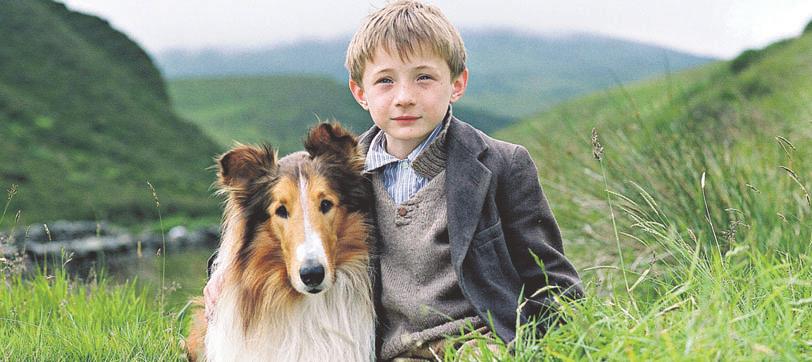
Open Season Flicka Everyone’s Hero Lassie
Handsome adaptation of Eric Knight’s original novel, “Lassie Come Home,” about an impoverished Yorkshire mining family (Samantha Morton, John Lynch and Jonathan Mason) in World War II that reluctantly sells its beloved dog to a rich nobleman (Peter O’Toole) who takes the dog to Scotland where the collie escapes and attempts the impossibly long trek back home.
Writer-director Charles Sturridge has assembled a fine, mostly English cast, including Edward Fox, Kelly MacDonald and Jemma Redgrave, and two appealing youngsters, Mason and Hester Odgers. The scenic vistas are breathtaking
and the story appealing, making this fine family viewing, though discerning adults may be bothered by a disjointed narrative, some plot turns that defy credulity, and an awkwardness in both script and direction that places it several notches below the classic 1943 MGM version.
A brief sequence of Lassie being beaten with a belt, a nongraphic scene where the miners urinate to throw some hunting dogs off the scent of an escaping fox, some mildly crass language, some mild violence and the death of a dog. The USCCB Office for Film & Broadcasting classification is A-I - general patronage.
discovery November 2006 Page 6
Worth the wait
Australian rugby league superstar Jason Stevens experienced the life of a rock god, but soon found out the sexual escapades that came with it ain't all they’re cracked up to be.
■ By Mark Reidy
Jason Stevens is a powerful man with a powerful message. Standing at 192cm and weighing in at 112kg he has regularly represented Australia and NSW in rugby league over the past 14 years, but it is his message of hope and inspiration for young people that has won

him the respect of many outside the football arena.
In the early years of his illustrious career, Jason found himself taking advantage of the sexual opportunities that high profile sportsmen often encounter.
However, by the time he was 23 he was becoming frustrated by the invariable failure of these relationships.
It was at this time that his brother Paul, who played alongside him with the Cronulla Sharks, announced that he had chosen to abstain from sex until after he was married.
Jason, a Cleo Bachelor of the year runner-up (see photo), revealed that his initial reaction to his brother’s decision was one of astonishment.
gift to humanity and that God wanted it to be used in a very special way.
“God is not a killjoy,” Paul told him, “He has an overwhelming love for us and it is because of this love that he has created sex and has given us some guidelines on its use”.
These guidelines, he shared, were designed to protect people from hurting themselves and one another and from missing out on the full enjoyment that sex had to offer. Through his brother, Jason discovered that God had designed sex as a powerful expression of one person’s love for another and that it was much more than just physical pleasure. “It has the power to create another human being, “Paul had explained. “God intended sex to bond two lives in love. That’s why he asks that we save sex for marriage only.”
This message resonated with Jason and the pain that he was experiencing. “Until this point I did whatever my hormones felt like doing and found myself emulating my friend’s values and those presented on TV, instead of developing my own,” he said.
“I am convinced that all my previous relationships slid
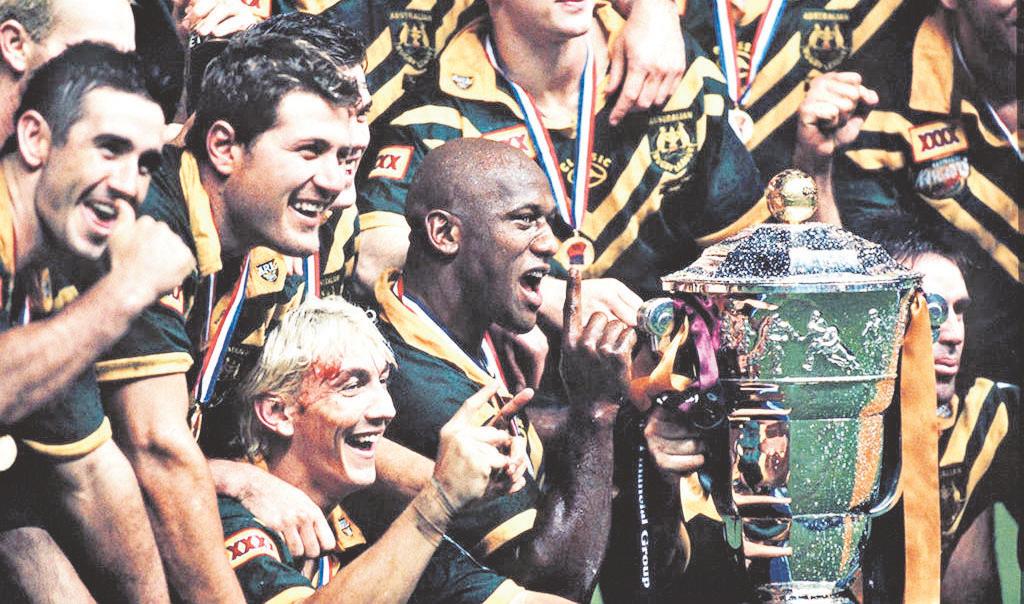
top of the world:
downhill the moment we began to experiment with sex. Sex at the wrong time can prevent you from experiencing true love and destroys what may have been a good relationship.”
Jason has remained faithful to his promise for eight years now and in that time he has written a book, “Worth the Wait”, which promotes the abstinence before marriage lifestyle.
In his book Jason claims that by giving into lust it is easy to fool oneself into believing that a relationship is better than it actually is. In his own life he said that it confused his ability to think clearly about the other person because he became so focused on the sex that he was unable to experience them as a whole person.
“Having sex at the wrong time attacks the very things that help build a relationship, like trust, which makes friendships enjoyable and worthwhile”, he writes.
“Trust within relationships is established when the people involved show that they can control their urges and emotions”.
He adds: “People might think that I am making a big sacrifice - and I am - but the rewards will
far outweigh the sacrifice in the end.”
Paul is equally passionate about living a chaste single life. “Society has confused the intensity of sex with the intimacy of love”, he says in his TLW testimony.
“In simpler terms, society tells us that sex is like a beat up old Volkswagen, which is not worth much, so you lend it out to anyone of your friends for use.
“However, God treats sex like a brand new Porsche.
“Something that is very special and that should only be shared by your husband or wife."
For further information on Jason Stevens see www.jasonstevens.info

JASON’S TIPS ON STAYING IN CONTROL
I deal with my sexual urges by:
• Staying close to God and close to people who love Him
• Not allowing myself to daydream - I refocus my mind
• Avoiding music and shows that make me think about sex
• Switching off the TV straightaway if a sex scene comes on
• Consciously controlling my thoughts
• Realising that temptation will always be there, however it’s my choice whether I act on the temptation
• When an attractive girl walks past, you can’t help but first look and admire her. But it’s the second look that gets you in trouble.

“I told Paul he was nuts,” he said in a testimony on the True Love Waits (TLW) website, “but a few months later, I was making the same decision.”









For more information call 9223 1396 e-mail: admin.nfs@aanet.com.au or visit www.acnfp.com.au

Paul shared with Jason how he had discovered Jesus and had come to realise that sex was God’s










Natural Family Planning




















discovery November 2006 Page 7
Achieving, avoiding, spacing pregnancy, breastfeeding, menopause, coming off the pill Medically and scientifically accurate As effective as the oral contraceptive pill
On
Jason Stevens (second from left) with arguably the best league player in the world, Andrew Johns (far left), former Wallabies star Wendell Sailor (with trophy) and Wallabies hero Mat Rogers (blond hair) who is one of Stevens’ best mates, after the Australian Kangaroos’ victory over New Zealand at Old Trafford which clinched the 2000 World Cup.
Idol: Sevens’ Cleo Bachelor of the Year runner-up photo shoot.
Unstoppable: Stevens’ Sharks days.
The Committee for family and for life
This is the first edition of the Committee For Family and For Life’s (CFFFL) Newsletter to be inserted in Discovery. We thank The Record for allowing us to reach a wider audience. Eighteen months ago, the concept of a Newsletter, to share information of what is available in our Diocese, and to encourage and support families and life issues was only a dream.
cd
Take ’em on together
The Committee for Family and for Life was called together initially by the late Bishop Healy as a local response to an initiative of the Australian Bishops’ Conference to promote family and human life at all stages. The Archdiocesan Committee has embraced the mandate of the Bishops’ Committee for Family and for Life. Our committee recognises the importance of the family to our society and realises that in today’s world, it is not easy to build and maintain healthy family relationships in a faith context. Being a member of a family is truly a vocation. Our committee wishes to encourage and promote the vocation and spirituality of marriage and the family; to encourage and promote respect and love for human life from conception to death.
The task of the committee also is to inform me, your Bishop, and leaders of the Archdiocese, of the challenges and issues in public life affecting the ideas of marriage, family, and the defence of human life.
Our committee is really excited to be part of Discovery For the last 12 months we have struggled to print and distribute a total of 1000 copies to parishes, schools
The Committee members:
and organisations. Now that the Newsletter is included in Discovery it means we have an audience of 55,000.
We hope to continue to meet your needs by providing information and articles that will truly reflect what is happening in your situation. With your help we can support those who encourage the positive development of family and life values.
Contributions to our newsletter come from all different kinds of sources. We have had articles submitted by teenagers to octogenarians.
Not every contributor to our Newsletter comes from the perfect family. We all struggle in our relationships, and in our spirituality.
It is not easy being a Catholic in today’s society. Through my involvement with the Committee for Family and for Life I have become aware that there are a lot of good people out there who have found a way of making life better. Our committee wants to hear from you. How are you coping with family life? How can the Church help you? What have you found helpful? If you have an issue that you wish to share with our community, please contact any of the committee members listed below.
Bishop Don Sproxton 9223 1351; Kerri Sorgiovanni 9448 4478; Fr Doug Harris 9444 6131; Dorothy Beyer 9286 2897; Jennifer Skerritt 9243 0966; Barbara Harris 9328 8113; Carmen Court 9316 4434; Joe O’Brien 9314 2190; Derek Boylen 9325 1859; Lydia Fernandez 9328 2929; Phillip and Helen Lee 9361 0508
CFFFL LOGO NEWS
Thanks to all the people who took the time, and the effort to submit designs for a logo for the Committee for Family and for Life. Your efforts are making the committee work very hard in choosing one of the designs as the winner. The next edition of Discovery will announce the winner, along with other award winners.


After 40 years of marriage
George felt suicidal. His wife had died 12 months previously.
“Life is not worth living,” George said.
Debbie was living alone after a marriage of 14 years and a committed relationship of 20 years had ended. “It felt like nothing was working in my life. I was stuck.”
Christine was hurting deeply about the ending of her marriage.
“I was finding it difficult to let go of the 25 years of being half of a couple. My whole world had changed’” she said. “I had lost the ability to trust.”
After attending a Beginning Experience weekend Christine, Debbie and George expressed deep gratitude to friends who had recommended this healing experience. “The caring team taught me the value of myself and led me on the path to trusting others again,” said Christine.
Beginning Experience grew
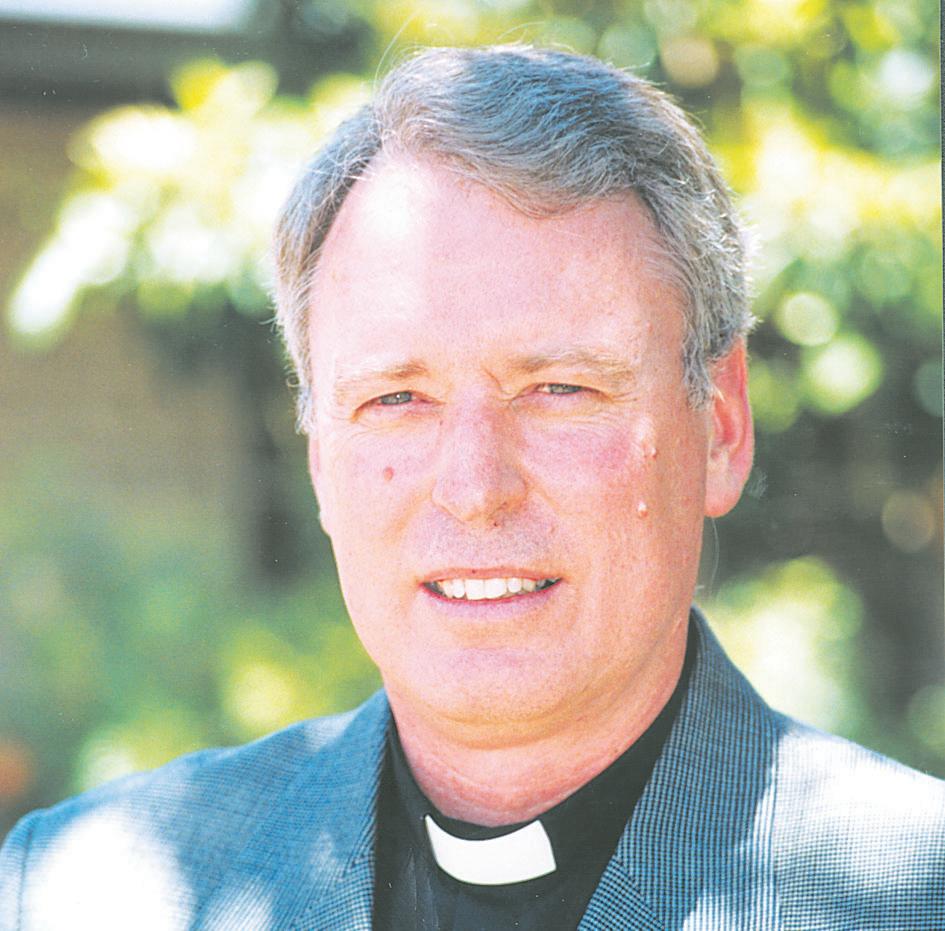
Get up to speed with the Net before it’s too late

Cout of a Catholic initiative based on Marriage Encounter by Sister Josephine Stewart and her divorced friend Jo Lamia in the USA in 1974. Beginning Experience is now operating in 150 centres throughout the world and has been in Perth since 1984. The vision of Beginning Experience is that widowed, separated and divorced people will work through their grief, be healed, transformed and free to love again.
Most of us enter marriage believing it will last forever and when this dream is shattered by death, separation or divorce, our world is turned upside down and traumatised with nearly unbearable feelings of loneliness and grief.
George had given up work to nurse and care for his wife during the last 18 months of her battle with cancer. Without his loving and supportive wife, George had little reason to get out of bed, cook for himself or return to the work environment and activities he had enjoyed before her illness and death. The love and support of his children and grandchildren were not enough to keep the feelings of hopelessness and despair from overwhelming him.
During their Beginning Experience weekends, Christine, Debbie and George found they were not alone in their grief and helplessness. “I cried for most of the weekend,” said Christine. Others in their small group shared similar feelings of anguish, loss, guilt and anger. The weekend was not a counselling experience. It was about acknowledging and expressing personal feelings without fear of judgement, of not being told to get on with life and look forward to the positive things.
They felt relieved to know their feelings were valid. The facilitators were single people like themselves who had suffered similar marriage losses and understood the painful struggles they were living with.
Debbie had been harbouring resentment and ill feeling as she had lost a lot financially in her last separation. “A light came on for me. I realised I had not forgiven Barry,” she said. The Beginning Experience program offered a time of reconciliation and Debbie experienced this as life giving. It is one year since she participated in a Beginning Experience weekend and she is now able to develop new friendships. She is no longer stuck. “Beginning Experience provided me with love and hope for a future. It saved my life,” said George. “There are still days when I feel depressed but I have joined a choir, I am dancing and I am involved in community work. The good days far outweigh the dark days.”
Though rooted in the Catholic tradition, Beginning Experience serves those of all faiths with its open ecumenical spirit. “I am now able to pursue a productive life guided by sound Christian principles,” said Christine, who is not Catholic.
The weekend program for Beginning Experience is held in March and September for those who have come through the initial stages of grief and are ready for a new beginning. Beginning Experience also offers a Coping program for those recently widowed or separated, held over two Saturdays or one night a week for six weeks. Coping is offered in Busselton and Perth in January. For more information about the Beginning Experience contact Bev on 9332 7971 or Margaret on 9294 4892.
The Archdiocesan Committee for Family and for Life Newsletter, through Discovery, can be downloaded from the Internet. Go to the Perth Archdiocesan homepage www.perthcatholic.org.au, click “organisations”, then click “ecclesiastical organisations”, then click “Committee for Family and for Life”. The Newsletter is available in alternate formats, Braille, Plain English text and on audio tape by contacting Natalie on 9242 4066 at the L.J.Goody Bioethics Centre.
atherine Kolomyjec, Community Relations Officer at Aranmore Catholic College said “while our children embrace new and continually changing technology, it is often difficult for us as parents to know what to do, to support their learning and to protect them from the many dangers that are evolving as fast as the technology itself.”
Catherine decided to be proactive in this new cyber world; organising an Internet safety talk for parents from the College and from the surrounding primary schools.
The school invited the WA Police’s new Cyber Predator team to present some of the issues. The team highlighted some of the strategies parents can take in teaching their children protective behaviours.
Catherine spoke to one father and his son before the talk to find out their thoughts around the issue.
Dad said, “I have a functional understanding of the computer for work but I feel insecure not knowing how children are engaging with this technology and what they are actually engaging with. His son said, “the amount of time I am allowed on the computer is an ongoing issue. I like to go on to the gaming sites. I’ve never really heard about any bad stuff happening”.
Sergeant Dean Worthington from the Cyber Predator Team of WA Police and Acting Detective Superintendent Kellie Properjohn from the Major Crime Division explained that there were two major groups in society who used the internet; young people and child sex offenders.
“Young people use the internet for study, but the primary use is social interaction. Chat rooms and gaming sites have become popular ways for young people to talk but have also become easy avenues for bullying and for cyber-predators to engage with young people.”
The Cyber Predator team shared some very frightening cases of just how easy it is for predators to engage with children, using teenage language, knowing teenage culture and getting children to a point where they feel safe enough to agree to meet their new friend.
The team provided some tips:
• Put the computer in a public area of the home where you can supervise and engage with your child.
• Spend time with them online teaching them how to do internet searches and what personal information they should protect when on the net.
• Teach your child about Stranger Danger. They wouldn’t give their details to a stranger on the street so why do they do it on the net?
MARK YOUR CALENDARS
WEEKEND NEXT YEAR OCTOBER 5-7, 2007
Committee for Family and for Life hosts
• Monitor every name on your child’s contact list and make sure that they only have true friends on their list. Many children think that the longer their list is, the more popular they are so they will keep adding strangers.
• Explain to your child that they should not respond to anything that makes them feel uncomfortable and that they should leave the site and let you know about it. Particularly don’t use web cams with strangers or agree to meet anyone.
The parents who attended the talk were visibly shocked by the information presented and a number of parents said it was the most important talk they have ever attended as a parent. Some parents were rushing home to check their children’s contact lists and to explore the most popular chat rooms.
chat sites. I reckon all Year 8s should learn about it as it certainly would affect a lot of students who like to use chatrooms.”
Paul said: “The positives were that I came away with a knowledge base that I could talk to the kids about. Prior to this, I had no real idea of how the gaming system worked. Now my son and I joke about it all but with some idea of the implications and that is a relief.
I was also relieved that the police are so strongly focused on issues of child abuse”.
“CELEBRATE FAMILY CELEBRATE LIFE”
HAPPENING
Families and individuals will be invited to participate in a weekend of celebration,
• getting to know each other
• getting to know what is happening in the Archdiocese,
• learning how to enrich your family,
• celebrating diversity and difference

After the presentation some students said, they always thought that they could guess who the paedophiles were when they were on the gaming sites but that they were not so sure now. The talk made them very determined not to go off sites to chat to anyone they met while playing games.
One Dad, Paul, thought the seminar was terrific. “The shock for me lay in the recognition that people could have such impure motives. The idea that men (mainly) will engage to the degree they do in such a premeditated manner over some period of time to entrap children is horrifying. Also, that children (mainly girls) are so ready to disseminate personal information over such a wide area is enlightening. Again this fits with the manner in which girls might emphasise relationships and measure their success by the number of people’s names on their mailing list!” His son said: “I learnt a lot. I realised afterwards that I didn’t know anything. It has reinforced for me to not go anywhere near
“In terms of strategies we will continue pretty much as we have been”, said Paul. “That is, we will continue to restrict access to electronic stimulation, not out of fear of cyber predators, but because it gets in the way of school work and family life and exercise. This is especially so during the school week but less so on the weekend, although still restricted. If the kids are logged on we will expect to know what they are logged on to, and how they are engaging, and we will emphasis a rational discussion of how personal information should be managed in the internet and why.
“The computers used will still be in the office adjoining the kitchen and living room in clear view and there will be no computers or TVs in their rooms. We will continue to emphasise the use of the internet as a tool, not as a primary source of social connection. The emphasis is on our capacity to connect with people in a conversational manner face to face”.
Catherine said: “Aranmore is grateful to the WA Police for supporting the families of our local community with this informative presentation and their ongoing work to reduce cyber crime in our society. The College will continue teaching its students and parents about cyber safety and protective behaviours by integrating it into the Year 8 curriculum from 2007 and including it as part of the Year 8 Parent Night each year”.
RESPECT LIFE YOUTH CONFERENCE
EMBRACE THE GRACE
December 6-10, 2006
This four day over night event is held in the majestic town of New Norcia for youth 16 years and over from various groups, parishes and backgrounds of our community.
More information from Clare Pike, Respect Life Office (08) 9375 2029







discovery November 2006 Page 8 discovery November 2006 Page 9 We can help: - married couples experiencing fertility difficulties or miscarriages - women with menstrual or other women’s health problems - couples wanting to learn about their fertility and plan their families naturally For a confidential discussion contact Dr Amanda Lamont, 9440 4530f: 94404373 The Magnificat Fertility Care Centre Suit 15, DR7 Medical Centre 162 Wanneroo Rd Yokine, 6060 A unique natural medical approach to your fertility. FERTILITY CARE
Unity: Acting Detective Superintendent Kellie Properjohn from the Major Crime Division and Sergeant Dean Worthington from the Cyber Predator Team of WA Police with two students from Aranmore College.

Everybody loves to party - even in Sudan
In western cultures there are so many traditions and family concepts that we take for granted. For example, family relationships, customs and behaviours, naming, ways of celebrating, even when and how we celebrate birthdays. Mary Magdalene Nadwa and her two children, Clare and Robert, have been in Perth just over 15 months. Recently Mary had her birthday and she, in Western style, held her first birthday party, inviting a number of guests to share in the celebration.
Mary and her two children were born in Sudan. During the internal wars 11 years ago, her husband was killed. Mary ran with her two babies to her aunt and uncle’s house, but they too were killed and Mary ran and hid in the bush with her two little ones to escape. After some time Mary came out of hiding and she walked with her
two children to Uganda where she spent nine years in a refugee camp.
Mary said: “Life was very difficult in the camp. I am the youngest of five children and my brother was killed in the war. I have three older sisters but I have not seen my sisters for 11 years. I have no idea what happened to them or where they are now.”
Fr Ken Asaba, assistant priest at St Anthony’s Wanneroo, who also is from Africa, said: “Birthday celebrations are not really part of the African culture as we have it in Western culture. As there is a lack of records kept, sometimes the exact date of the birth is not even known. In Africa we celebrate birthdays at the beginning of a child’s life, immediately or soon after the baby is born.”
“In Sudan, the birth celebration is made seven days after the birth of the child. This is also the time when the child and the mother come out

Women in prison
Margaret Ker is the Social Issues Convenor of the Catholic Women’s League of Western Australia. We have invited Margaret to share with us some of her insights into an area that most of us know only from watching TV shows.
Margaret writes: “Women in prison in Western Australia are arguably more cut off from the general community than any other group of women. Often prior to imprisonment they have already encountered multiple problems in their lives. Their ability to cope, on release, with an increasingly complex society is limited.
First beginnings
Since 2001 the Catholic Women’s League has been involved in a project to be neighbours to women in prison. Members of the Catholic Women’s League know the complexities of modern family life and are in a great position to affirm the efforts of women in prison to keep their families together.
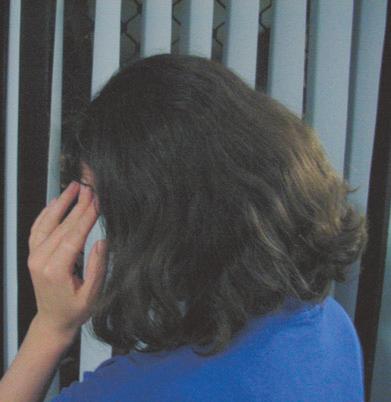
10. The proportion was much higher among Aboriginal women prisoners.
Over half the women in prison had diagnosed mental health problems (most commonly anxiety or depression), and a similar proportion had contemplated or attempted suicide.
Positive outlook
In spite of this, 66 per cent of respondents believed they were unlikely to re-offend after release However, 58% expressed concerns over their release and return to the community.
The Catholic Women’s League realised that women in West Australian prisons faced so many difficulties in returning to the community that it is hardly surprising if they lose faith in their ability to handle the transition.
of the house into public life for the first time. It is also the time that the name of the child is revealed,” said Mary.
“My two children, Clare and Robert have different surnames.
The ‘surname’ depends on something significant, for example, grandparents’ names, the season or even the time of birth. For example, if the baby came at night, the child’s second name may be translated ‘dark’. My son Robert’s surname is ‘Kinako’. This means ‘he is the one’,” Mary said.
“For the birth celebration”, Mary said, “everyone is invited, especially the relatives and friends.
Then food is prepared in plenty. There is normally traditional food and beer according to the culture. Some typical foods and drinks are cassava leaves, Ugali (semolina), busaa (local beer made from maize flour and yeast), chickens, goats and sheep. People bring gifts in different forms but the people’s presence is more important. The family relations would help with cooking and setting up the place.”
Mary said: ”We are very lucky to be here in Perth. We can wait for many, many years in the camp before we are allowed to come here.”
Mary’s “cousin-brother,” denoting another difference in ways of describing family, was allowed to come to Perth some years before Mary. He was able to sponsor Mary and her children through a money loan organised through the Edmund Rice Centre in Mirrabooka. Mary and her children are happy to learn how to become the best Australian citizens.
The initial impetus for the project was a study of women in prison in Western Australia, published in June 2002 by the Department of Justice, which provided a useful overview of some underlying problems. A further survey in 2005 confirmed this general picture.
Family visits few
Margaret said, “It is sad that while almost half of the women in prison had been primary carers of either children or (less commonly) adults prior to imprisonment, they received no visits at all from them during imprisonment. Less than 10 per cent preferred not to be visited.”
Margaret also noted with deep concern the background of women prisoners. Lack of formal education rated highly.
Some 40 per cent of the women prisoners had not completed Year

Children
The children of women prisoners are likely to be substantially disadvantaged on an ongoing basis, vulnerable families locked in a cycle of vulnerability. The Catholic Women’s League offers a practical response to the need, providing as it does for families visiting women in prison.
Christmas party
The Catholic Women’s League has since 2002 supported the Christmas party for the children of prisoners. From small beginnings it has grown to cater for over 500 children of all ages at several venues.
Each child receives an appropriate gift, possibly the only one they receive, and they are able to spend some time together as a family.
Margaret explained that the focus of the Catholic Women’s League Christmas Party is on the needs of the older age group.
Something as simple as a couple of movie tickets and a few fast food vouchers can enable teenagers to return to school at least with something in common with their classmates.
Hope
Margaret said how the Catholic Women’s League hopes their reaching out to women in prison will make a difference. The League’s work with women in prison is one way they give thanks for Jesus, whose witness to the power of unconditional love made a difference to all of us.
If you would like to contribute to the Christmas Party organised by the Catholic Women’s League please telephone (08) 9328 4767.
discovery November 2006 Page 10
Preparations: Here in Australia there is plenty to eat.
Birthday: Nothing like a good birthday celebration.
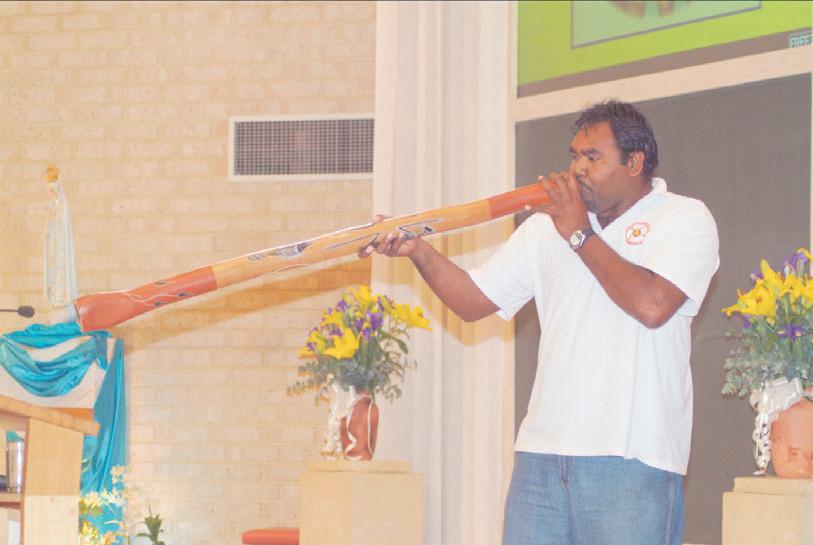
Generosity goes global in schools
■ By Anthony Barich
West Australian Catholic school students united with public schools last week to send a powerful message in unison with students from around the globe.
Since succeeded Pope John Paul II, Pope Benedict XVI’s challenge to Christians worldwide has been to use the Liturgy to spur others into actions of kindness and humility, and to unite in solidarity for the Eucharist.
In response to that, last week, to mark World Children’s Mission Day, over 700 students converged at Bateman’s St Thomas More parish to join Bishop Don Sproxton, Mgr Michael Keating and Deacon Bruce Talbot with 10 concelebrating priests from around the world, plus priests, brothers and nuns from 15 orders and 12 agencies within the Perth Archdiocese. The 10 international priests were from India, Africa, Poland, South Africa and South America, and they joined Bishop Sproxton for the Eucharistic Prayer.
It was the single-biggest gathering of schools since Children’s Mission Day started being celebrated by schools three years ago.
This year, uniting for the theme “Word of God: Live It!”, a record 84 Catholic schools from the diocese – 16 of which had a hand in the Mass celebration – joined six public schools and a representative from the Bunbury Diocese united to offer solidarity to support Catholic Missions.
The public schools were significantly represented because, as Catholic Missions director Francis Leong said, a staggering 60 per cent of Catholic students in the Perth Archdiocese attend public schools.
They have not been forgotten and they are crucial to the future of the Church.
Last year the event drew 80 Catholic schools, up from 52 in 2004 and 44 in 2003.
That’s just over half the number of schools represented last week. Students and principals from two country parishes –Goomalling and Northam – also
made the trek for the event. It was an affirmation of the Catholic ethos and character of WA’s schools and the fundamental link with the universal mission of the Church, since the reason for the Mass was to offer solidarity with the Pontifical Missionary Society for the Holy Childhood.
The PSHC is over 140 years old –long before World Mission existed.
PSHC currently funds some 2700 mission projects throughout the world in child health, education, welfare and pastoral care, run by the Catholic Church through dioceses and Missionary Orders in 160 countries.
Next year, appropriately, Our Lady of the Mission in Whitfords parish will host the event on the corresponding Wednesday.
Mr Leong said youth are the future of the Church, and they made a significant statement with their participation and prayers last week.
“As Pope Benedict said, the Liturgy is an important way to spread the mission message,” Mr Leong said.
“It is a powerful sign, and we can use it to inspire the future generation of Catholic Church members in Perth, because without them, we’re lost.”
Homilist Fr Michael Merrifield, from Port Kennedy parish in the Perth Archdiocese, spoke while presenting a Powerpoint slideshow of his experiences in countries where missions are badly needed.
“It’s like going into a totally different world,” said Fr Merrifield, who spent 13 months in Manila and the Philippines before being ordained, and has since visited Mother Theresa’s homes for the dying and for children with leprosy in Calcutta.
“The money which Catholics provide through mission donations fund these homes, and mission funds also free them from the trap of poverty, and provide education.
“These homes for the dying would not exist if not for the funds from mission donations.”

The silver ring thing
■ By Mark Reidy
The vision of the Silver Ring Thing (SRT) program is to create a cultural shift in America that will see sexual abstinence become the norm rather than the exception. The program offers participants the opportunity to take a pledge of abstinence until marriage, symbolised by the placing of a silver ring on their fingers.
Created in 1996 by Denny and Amy Pattyn in Arizona, as a response to the escalating number of teenage pregnancies, the program is now the fastest growing of its kind in the US.
The Pattyn’s realised that the distribution of condoms and the promotion of “safe-sex” was not providing young people with protection from the physical, spiritual and emotional problems resulting from pre-marital sexual activity.
They believed that the only way to reverse the moral decline

that teenagers across America were experiencing, was to inspire a change in the conduct and behaviour from within the culture.
The program is not only for those who have yet to engage in sexual activity, as it also offers a new beginning for those wanting to embrace a “second virginity”.
Through a combination of music, high-tech laser show, comedy and drama sketches and appealing video presentations, SRT has been able to carry its faithbased message to thousands of young Americans and its national plan is to reach 20 percent of the student population.
The program is presented by young people and promotes the alarming statistics of sexual disease and teenage pregnancies in conjunction with the spiritual and moral message of Christianity.
The success of the program has seen it spread internationally, with






programs now running in the UK and Africa.
In South Africa in 2005, a group of 12 presenters delivered the SRT message to 67,032 young people during 102 shows, which resulted in 18,213 signing pledges of abstinence before marriage. The goal is to have one million South Africans wearing a silver ring by 2010.
Concern about the increasing number of sexually transmitted diseases and pregnancy amongst teenagers is gaining momentum. In 2004 the US Government promised to provide at least $133 million annually for the next five years to abstinence based programs. It seems that a growing number of people are embracing the message.
For further information on Silver Ring Thing see, www.silverringthing.com




discovery November 2006 Page 11 0 0 0 0 0 0000 0000 0000 0000
Indigenous performance: A special performance at Bateman.

Ph: 94054777, Fax: 93062629, Email: materdei@mdc.wa.edu.au
PRINCIPALSHIP
ST JOSEPH’S PRIMARY SCHOOL BUSSELTON
St Joseph’s Primary School is a double stream coeducational school with an enrolment of 461 students from Kindergarten to Year 7. Busselton is 232 kilometres south of Perth and lies at the heart of some of Western Australia’s most spectacular scenery.
St Joseph’s offers a curriculum based on the integration of faith and life that promotes the religious, social, cultural and physical development of each student. The School Board and the Parents and Friends’ Association work closely together to support the school with resources and educational programs.
The academic program includes specialist teachers in Music, Art, Library, LOTE and Information Technology. In 2007 the school will move into the second year of the RAISe (Raising Achievement in Schools) Literacy program.
The successful applicant will be expected to take up the position on 1 January 2007.
Applicants need to be practising Catholics and experienced educators committed to the objectives and ethos of Catholic education. They will have the requisite theological, educational, pastoral and administrative competencies, together with an appropriate four-year minimum tertiary qualification, and will have completed Accreditation to Teach Religious Education or its equivalent.
A current Federal Police Clearance/100 Point Identification Check or WACOT registration number must be included. The appropriate Police Clearance Consent Form is available from the Department of Education & Training website (www.eddept. wa.edu.au/teaching/downloads/policeclearance.pdf).
The official application form, referee assessment forms and instructions can be accessed on the Catholic Education Office website www.ceo.wa.edu.au
Enquiries regarding the position should be directed to Helen Brennan, Consultant, Leadership Team on 9212 9268 or email sch.personnel@ceo.wa.edu.au All applications, on the official form, should reach The Director, Catholic Education Office of Western Australia, PO Box 198, Leederville 6903 no

Breast cancer risk grows

Married couples a minority in America
Married couples have slipped into a minority in the United States over the past five years.
A Major US Study Shows Oral Contraceptives Increase Breast Cancer Risk 44 %
■ By Gudrun Schultz
PITTSBURGH, Pennsylvania,Oral contraceptives increase the risk of breast cancer by an average of 44 percent, a comprehensive analysis of world studies on the link between breast cancer and contraceptives has found.
Published in the journal of the Mayo Clinic this month, the key article examines findings from a careful analysis of international studies conducted between 19802002.
Entitled “Oral Contraceptive Use as a Risk Factor for Pre-menopausal Breast Cancer: A Meta-analysis, the article finds an increased risk for breast cancer of 44 percent, in pre-menopausal women who took or were taking oral contraceptives prior to their first pregnancy, compared to women who had not used oral contraceptives.
Of the twenty-three studies examined, twenty-one showed an increased risk of breast cancer with oral contraceptive use prior to a first pregnancy in pre-menopausal women.
The combined results showed an
over-all risk increase for breast cancer of 44 percent.

Dr. Chris Kahlenborn, lead author of the report, said his entire team believes the standards of informed consent demand that women must be warned of the potential risk of pre-menopausal breast cancer before they take oral contraceptives, in a press release from the Polycarp Research Institute.
Breast cancer is the leading cause of cancer in women worldwide and the most common cause of cancer death in US women between age 20 and 59, the report stated, pointing out the breast cancer rates have risen steadily over the past four decades worldwide, and have risen even faster in developed countries, especially among young women.
The study re-enforces the 2005 classification of oral contraception as a Type 1 carcinogen (cancercausing agent) to humans by the International Agency for Cancer Research.
Researchers have increasingly warned about an additional link between breast cancer and abortion, found to be significant in multiple studies throughout the world.
The abortion/breast cancer link has been consistently ignored or denied, however, by leading cancer institutes in Europe and North America.
LifeSiteNews.com
Chastity is real
After 18 months of dating, Andrew Pilcher and Lara Bianca Hatch kissed for the first time and it just happened to be on their wedding night. The Perth couple married on June 17 this year, and had mutually agreed to save the entire physical aspect of their relationship until their wedding night.
The couple’s story appeared on the front cover and page three of ‘The West Australian’ on the day of their wedding and also featured on Channel Seven’s Today Tonight program a few days later.
The newspaper report said Mr Pilcher, a physiotherapist, and Miss Hatch, a high school drama teacher, had agreed from the beginning of their relationship to remaining celibate and refrain even from kissing until their wedding night.
Guided by their Christian
The American Community Survey, released this month by the Census Bureau, found that 49.7 per cent, or 55.2 million, of the nation’s 111.1 million households in 2005 were made up of married couples - with and without children - just shy of a majority, and down from more than 52 per cent five years earlier.
The figures apply mainly to people in the 25 to 34 age-group (Among Americans aged 35 to 64, married couples still make up the majority of all households).
The survey estimated that 5.2 million couples, a little more than 5 per cent of households, were unmarried, opposite-sex partners. Other estimates put households of male couples at 413,000 and female couples at 363,000.
In all, nearly one in 10 couples were unmarried, and one in 20 households consisted of people living alone.
It appears that many unmarried couples consider living together as a practical step from a financial and time management point of view, and a “test drive” for marriage.
But delay also means couples are “finding they’ve gotten so good at being single it’s hard to be at one with another person,” suggests Steve Watters of Focus on the Family.
- New York Times
School systems struggle with religion
faith, the couple wanted to firstly become “best friends” and decided to limit contact to holding hands, hugging and rubbing noses. “It’s not like we signed a document saying, ‘We are never going to kiss”, Miss Hatch said, “But kissing can quickly lead into foreplay, so we thought it best to steer clear.”
Mr Pilcher said that he had no doubts that their physical relationship after the wedding would be “passionate and amazing”. He shared that they had waited for a month before they held hands for the first time and said, “the electric feeling was amazing.”
Both agreed that the temptation to break their pledge had been tough at times but believed that the wait would be worth it. “We have so much chemistry”, Miss Hatch said, “And we have a whole lifetime to learn.”
The Quebec government is struggling to find ways to accommodate religious groups’ demands for greater freedom to exercise their rights in the province’s secular education system. School boards received a sudden increase in demands from various religious groups after the Supreme Court of Canada ruled last March that a Sikh student could carry a ceremonial dagger to class.
The ruling obliges schools to find a “reasonable accommodation” for religious groups. Two “clandestine” schools run by Christian sects were closed down recently because they were operating outside the governmentapproved curriculum. But education minister Jean-Marc Fournier is keen to avoid such situations.
“What good is it to put a policeman next to child to bring him to school when parents tell their child that what they are learning is no good?”
discovery November 2006 Page 12
later than 10 November
2006.
- Globe and Mail
Resisting a moral climate change
Catholic obstetrician says countries are not protecting a doctor’s right to conscience
■ By Carol Glatz
Catholic obstetricians who respect the dignity of motherhood and the life of the unborn risk disappearing in societies where abortion is legal, said the head of an international group of Catholic obstetricians and gynecologists.
Obstetricians who oppose having to perform abortions as part of their training or in their practice at public or private health care facilities sometimes face “a sort of medical totalitarianism” and feel tremendous pressure to “do it this way or not at all,” Dr Robert Walley, founder and executive director of MaterCare International, told Catholic News Service.
Walley and some 60 other obstetricians from 14 countries were in Rome from October 11-15 as part of the fourth MaterCare International workshop for Catholic women’s health specialists.
Part of the World Federation of Catholic Medical Associations, MaterCare was founded in 1995 to “serve the culture of life” wherever mothers and their children are neglected or abandoned, said the British-born doctor. This year’s workshop looked at ways the dignity of motherhood and the practice of obstetrics could be protected and promoted.
“I said, ‘No,’ and they said, ‘No, you have to do it and if not you have to either change your specialty or leave.’ And I chose to leave,” he said.
“Like the dinosaur who was frozen out by a climatic change, that’s happening to us,” Walley said, explaining that Catholic obstetricians who wish to avoid being involved with abortions are being “frozen out by the climatic change that occurred when abortion was brought in 30 years ago.”
When he started his studies more than 35 years ago, Walley said obstetrics was a prestigious and even joyful profession because the doctors were helping “the cocreators” of life bring a new child into the world and “the outcome was always happy.”
But all that changed with legalised abortion, he said, and most practitioners “became depressed.”
“It doesn’t matter what side of the argument you’re on with the abortion issue, nobody wants to spend their life doing abortions if you’re a trained surgeon, a trained gynecologist,” he said.
But he said the largest factor that has led to the drop in new recruits for obstetrics and gynecology is the climate of litigation.

“There’s a crisis in obstetrics because no one wants to go into it,” he said.
“The world now expects perfection and we can’t guarantee that,” he said.
Patients often sue the obstetrician, which then discourages people from continuing or even getting into this field. Walley said he had no idea how great an impact legalised abortion would have on his and other doctors’ lives and careers. He lived and trained in England, but was soon forced to leave when Britain’s state-run National Health System required him to perform abortions.
“I said, ‘No,’ and they said, ‘No, you have to do it and if not you have to either change your specialty or leave.’ And I chose to leave,” he said.
He moved to Canada, where he joined the faculty of a new medical school, and while the school did not require him to teach or perform abortions, “they weren’t happy I had a particular view of things, and that pursued me until I retired from clinical practice last year”.
“Every civilised country has always recognised conscientious objection even in the time of war, but not in the time of abortion, and it’s an outrage,” he said, adding that many countries, especially in Europe, do not protect a doctor’s right of conscience.
However, more than a decade ago the US Congress passed legislation that provided a protection of conscience clause when new regulations required abortion training in all residency programs.
Dr John Seeds, professor and
chairman of the department of obstetrics and gynecology at Virginia Commonwealth University in Richmond, Virginia, said half his residents are practising Catholics and that they openly enjoy their studies, even at this public, secular university.
“There’s not this evil cloud”
hanging over them that would have come with a requirement to study or perform abortions, said Seeds, chair of MaterCare USA.
Fr George Woodall, professor of moral theology and bioethics at Rome’s Regina Apostolorum
university, reaffirmed the importance of protecting the right and dignity of conscience, saying conscience does not reflect mere personal opinion or feelings, but reflects an individual’s desire to pay witness to truth.
He did, however, caution against an attitude of what he called “paternalism” when it came to doctors or health care workers not providing patients with information on procedures or services that go against their own religious beliefs.
“To deny a patient proper information so they can make an informed choice ... is paternalistic,” he said, but “choosing not to do harm” by refusing to carry out an abortion, sterilisation or euthanasia “is not paternalistic”.
It is morally licit, he said, for health care workers to look after a patient before or after her abortion “provided they don’t endorse it” or participate in preparations for the procedure.
“Counselling for an abortion is equally gravely wrong,” he said, even though some doctors think they should be part of state-run counselling programs in the hopes of dissuading the woman from having an abortion.
Seeds said pro-life individuals must continue to advocate for the unborn and keep up dialogue with people who do not agree with the church’s position.
“The pro-life movement of the church argues from a supportive and loving position, not a destructive, hostile position. We have to love it out of them... it’s the only way to make it work,” he said.
A new view for campus life
■ By Mark Reidy
Increasing pressure on Christian students at British universities to lose their virginity has inspired a six-week course designed to give them the moral strength to resist. The course, implemented by the evangelical University and College Christian Fellowship, is known as “Pure” and has already been piloted on 15 campuses.
Believed to be the first of its kind in Britain, the course, which is led by students, empowers participants with biblical texts and practical knowledge to assist them in their goal as well as spreading the gospel of sexual abstinence before marriage.
Director of the Fellowship, Rev. Richard Cunningham, said that the most difficult struggle that Christians faced at university was in the area of sex and relationships. “Pure was born when we were approached by a Christian Union leader dismayed at the number of people in the union who were going out with non-Christians,
feeling bitter about being single or sleeping with their boyfriends or girlfriends”, he said.
The course splits students into single-sex groups to discuss ground rules for behaviour and share knowledge and suggestions for protecting their sexual purity within a culture where promiscuity is rife.
Rev. Cunningham said that the course aimed to provide young people with ways to avoid situations in which they would be tempted as well as “to always have a reverse gear out of a physical encounter” if necessary.
James Meiring, a second-year medicine student at Sheffield University, who is involved in the program, said: “Freshers’ week is all about who can have the most sex.
“But as a Christian, I don’t want to have sex with a girl until I’m married. I’m in a relationship and I encourage my girlfriend not to wear very showy clothes, like low-cut tops, bare midriffs and
short skirts, because I find it very attractive.
“I’m not going to say it’s easy. My natural instinct is that as a red-blooded 21 year-old boy, of course I want to have sex. But when you get a relationship right, sex is saved for marriage, because it’s just for one person.”




-CNS discovery November 2006 Page 13
Embrace: Dr. John Bruchalski hugs patient Iris Ryan, who is 36 weeks pregnant, at the conclusion of her visit to the Tepeyac Family Centre in Fairfax, Virginia. Bruchalski, a Catholic, does not prescribe birth control. Photo: CNS photo/Paul Haring
Most women are not size 8
The advertising industry is waking up to the fact that women don’t want to look like the waifs and sirens of the magazines.
■ By Adela Lo Celso and Alegria DuranBallen
Walk through any city today and count the number of billboards using the female body as a sales pitch. You will soon lose count and, especially if you are a woman, feel offended and angry at the way women’s dignity is being trampled on.

The Buffalo Clothing Company’s hit a new low with its latest billboard: A woman wearing nothing more than a backpack and high heels.
The whole field of marketing is crying out for a new approach.
The prevalence of in-yourface female images has reached saturation point, says Harvard researcher Paloma Diaz Soloaga.
In a study she did for her PhD in Marketing and Public Relations, Soloaga found that there are typically five different representations of women in fashion magazinesobject woman; doll woman; sensual woman; mimic woman; traditional woman (see box on Page 15).
Although there is a greater usage of the first four types throughout the advertising industry, says Soloaga, there is a slightly increasing tendency to use the fifth type.
She predicts that some smart forerunners will exploit this opportunity to gain an edge on their competition by promoting the real deal.
Positive trends
But there are more than market forces at work here.
In 1995 the United Nations Conference on Women held in Beijing adopted a Platform for Action which identified “the rapidly expanding media and mass communication industry as ‘a critical area for concern’, and one which must be urgently tackled if we
True love waits
■ By Mark Reidy
Growing global interest in a program promoting sexual abstinence before marriage arrived in Western Australia in 2000. From its humble beginnings in a US High-school in 1987, to its first National gathering in 1993, True Love Waits (TLW) has spread its message of chastity across the globe.
The essence of the campaign is to challenge young people to live a pre-married life of sexual purity by providing them with the opportunity to sign Pledge Cards committing to abstinence. To date over one million people have signed the cards.
While historically popular amongst Protestant groups, the Perth branch of this movement has been embraced by a group of young Catholics who began with the pledge program in 2000. They have since held one or two of these ceremonies each year, which is usually preceded by a Mass.
The group also provides regular formation sessions, which generally relate to John
are to move forward in achieving gender equality.” Whatever you think of “gender equality”, it can be useful to have a big gun like the

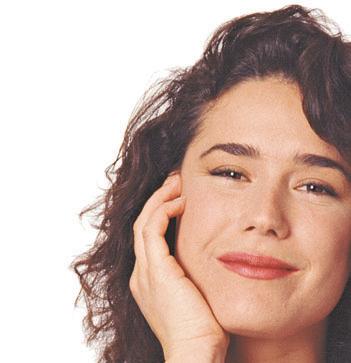


and entitled, “Women’s Image In Publicity”.
Paul II’s Theology of the Body.
These insightful teachings are focused on relevant issues and the struggles young people are faced with today in their sexuality.
Members of TWL Perth occasionally speak to High school students and interested groups about real love and dignity and to emphasise that young people do not have to conform to the false messages that are being promoted by society and the media.
For further details on TLW in Perth contact Truelovewaitswa@yahoo•com•au
Or phone Stephen Gorddard on 0431 228 630
For more information see www•lifeway•com/tlw/

TLW Pledge
“Believing that true love waits, I make a commitment to God, myself, my family, my friends, my future mate, and my future children to a lifetime of purity including sexual abstinence from this day until the day I enter a biblical marriage relationship•”

The purpose of the conference was to come up with strategies and concrete actions for breaking down the stereotypes of women. The image of an everyday woman - who eats, laughs, is a wife, a professional and a mother - is more than just an opportunity for the creative sector. It is also a social demand. In 1998, the UK Advertising Standards Authority published results of a study that showed 71 per cent of people felt offended by advertisements portraying women as sex objects.






















Sixty five per cent were unhappy with the way women are always portrayed as slim and stereotypically attractive.

governments. That is one inference we can draw from a conference organised by the European Union in May
In 2003, something similar occurred in Milan, the world’s fashion capital.A company called Moda e Modi in collaboration with the Universita’ del Sacro Cuore conducted a study through interviews with professionals and consumers of the creative arts.
“Any model in Madrid who does not reach a healthy body mass index (say 56 kg for a height of 1.75 meters) will not be allowed to walk the runway”
The clear message from these people was that beautiful models with long and sad faces did not represent them.
As one woman explained: “What bothers me the most is how models always look serious. They look as though they were angry
LifeLink target is $400,000
Archbishop Hickey’s annual Christmas LifeLink appeal has a target of $400,000 this year, slightly more than last year’s generous response.
The appeal will be conducted in all parishes next weekend, November 11-12, but donations can be made at any time.
LifeLink is the organisation through which the Archbishop funds 13 agencies which deliver a wide range of services to more than 50,000 families and individuals in WA each year.
In a personal letter to be distributed to Catholic families at Mass this weekend, November 45, the Archbishop reminds people that faith must be expressed in love• As Jesus said, “Whatever you do to the least of my brothers and sisters, you do to me.”
In the words of St John, “God is love, and he who abides in love abides in God, and God abides in him.”
At a liturgical launch for parish priests and parish representatives from 74 parishes last week, Bishop Don Sproxton said that the great
challenge of our faith is to befriend those who are homeless and those who are different so that through our gestures of kindness, our listening ear, our loving attentiveness they would come to know the great love Jesus has for them.
The agencies funded by LifeLink are:
• Anawim Aboriginal women’s refuge.
• Centacare employment and training.
• i.d.entity.wa, providing in-home and residential care for people with intellectual disabilities and their families.
• Natural fertility services.
• The Living Centre, formerly HIV/AIDS Pastoral Care Ministry.
• Emmanuel Centre, a self-help centre for people with disabilities.
• Djooraminda, providing out-ofhome care services for Aboriginal children.
• Centrecare, providing a range of services through offices in Perth, Cannington, Kalgoorlie, Joondalup and Mirrabooka.
• The Catholic Migrant Centre.
• Cross Roads Community, helping
people with addictions and their families.
• Samaritan Projects, for special needs that arise.
• The Catholic Association for Deaf and Hearing Impaired People (WA).
• The Shopfront, a meeting place in Maylands offering assistance, friendship, support and a referral service to marginalised people.
The agencies employ more than 500 people in fulltime and parttime positions, and they are supported by a similar number of volunteers• The total value of the professional and practical services they provide is estimated at $27 million.
Bishop Sproxton reminded the parishes that LifeLink helps everyone who reaches out, regardless of race, creed, colour or circumstance.
Many Catholic schools have associations with LifeLink agencies so that students can get practical experience in the works of Christian Charity.
Donations can be sent to LifeLink at GPO Box K828, Perth or by phone on 9223 1315. They are tax deductible.
discovery November 2006 Page 14
and smile
or sad. Therefore they do not give an image of what a woman their age is really like, even though they are wearing a beautiful dress.”
And another opinion: “I would like to see normal advertisements.
I think these are the ones that should predominate - illustrating normality. We are being used, represented in an exaggerated manner. It’s obvious we cannot go out in the streets looking like the models do in advertisement.”
Interestingly enough, similar attitudes are showing up on the catwalks.
Take, for example, the international repercussions of the new city regulations in Madrid.
Any model who does not reach a healthy body mass index (say 56 kg for a height of 1.75 meters) will not be allowed to walk the runway. This benchmark has been set by the Spanish Society of Endocrinology and Nutrition.
They are not solely worried about the models’ health.
They also take into account the ripple effect to countless number of teenagers who are dazzled by the supposed beauty of these models that in some cases anyway is only skin deep.
Avant-garde advertising
The catwalk-plus-health thematic has spread like wildfire through the international press, alerting the public to the new standard and creating expectations.
Advertising agencies and designers are taking the hint and coming out with new fashion concepts based on wholeness and naturalness.
Take, for example, the Spanish fashion brand Jocomomola and their slogan, “Eat very healthy.”
It turns out they are actually concerned about dangerous behaviour that could lead to health issues such as anorexia and bulimia.
This kind of motivation has been emerging right across the fashion industry.
Creativity is rediscovering its connection with integrity, with respect for the body and the person.
The fashion designer Elena Mirò uses models with a 46 figure size, which is a far cry from the sterotypical slim figure.
And yet they are charming and beautiful. Moreover they represent a size many medium-height women use to dress themselves from day to day.
Again, in Italy, the brand Caractère ran an advertising campaign last winter, where the main character was a distinguished and real woman.
In the picture, she wears the same jacket for completely different situations: to catch a cab, ride her bicycle, at work, going to the supermarket and, later on, out for the night. Advertising adds a magic
dust to the product or the service it is selling.
“This kind of motivation has been emerging right across the fashion industry. Creativity is rediscovering its connection with integrity, with respect for the body and the person.”
It repr esents a world of daydreams that allows consumers to imagine an ideal self.
But what real woman wants to look like the Photoshopped beauty with a sulky mouth and hollow eyes?
The woman who dresses herself

to go to work, to go out with her friends or to spend time with her family - this woman is a goldmine waiting for the marketers to open their eyes. The real magic dust in advertising would be to present a
woman who is fashionable in the natural, everyday world.
Adela Lo Celso and Alegria Duran Ballen are freelance Italian journalists. - Mercatornet.

The ‘five types’ of women portrayed in fashion magazines
Harvard researcher Paloma Diaz Soloaga found women overwhelmingly portrayed predominantly in five ways in women’s magazines:
· Object Woman: shows strong self-esteem and ego, promising seduction and pleasure. She never seems tired, wrinkled or weak. Usually she appears in night environments.
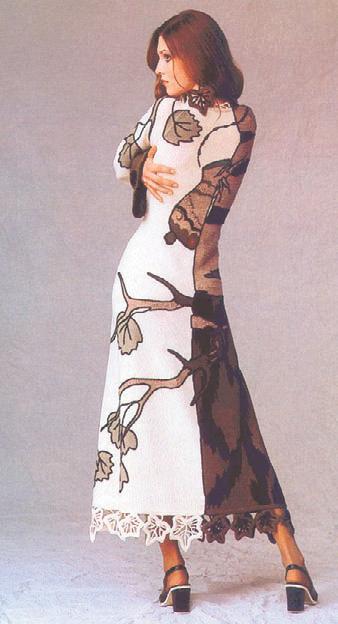
· Doll Woman: projects sadness, tiredness, weakness. Most of the time she appears in a self-regarding attitude. Invariably she sends the message that a woman’s body has merely aesthetic value.
· Sensual Woman: is beautiful but without too many expectations. She is not aggressive in her attitude but is associated with pleasure and seduction.
· Mimic Woman: is an active and socially intense woman. Her usual setting is luxurious and she can be classified as “high society”.
· Traditional Woman: is perfectly beautiful, but is closer to the authentic woman. She is associated with family, modernity and friendship. She is never overtly sexual, but frequently appears in leisure environments and activities.
discovery November 2006 Page 15 -
Up-coming events...
5
Applications for semester 1,2007 are open
Pre-University to Postgraduate – Something For Everyone
Notre Dame offers a wide variety of courses, offered at different levels for students from a range of academic backgrounds.
Notre Dame welcomes school leavers as well as mature age students from alternative entry pathways such as TAFE and Teaching Assistant programs. The University also offers the Tertiary EnablingProgram for students, who have not yet met standard entry criteria and wish to bridge into degree programs.
There are also a host of postgraduate level courses available ranging from postgraduate Certificates, Diplomas, Masters and Doctorate level qualifications. There is something for everyone at Notre Dame!
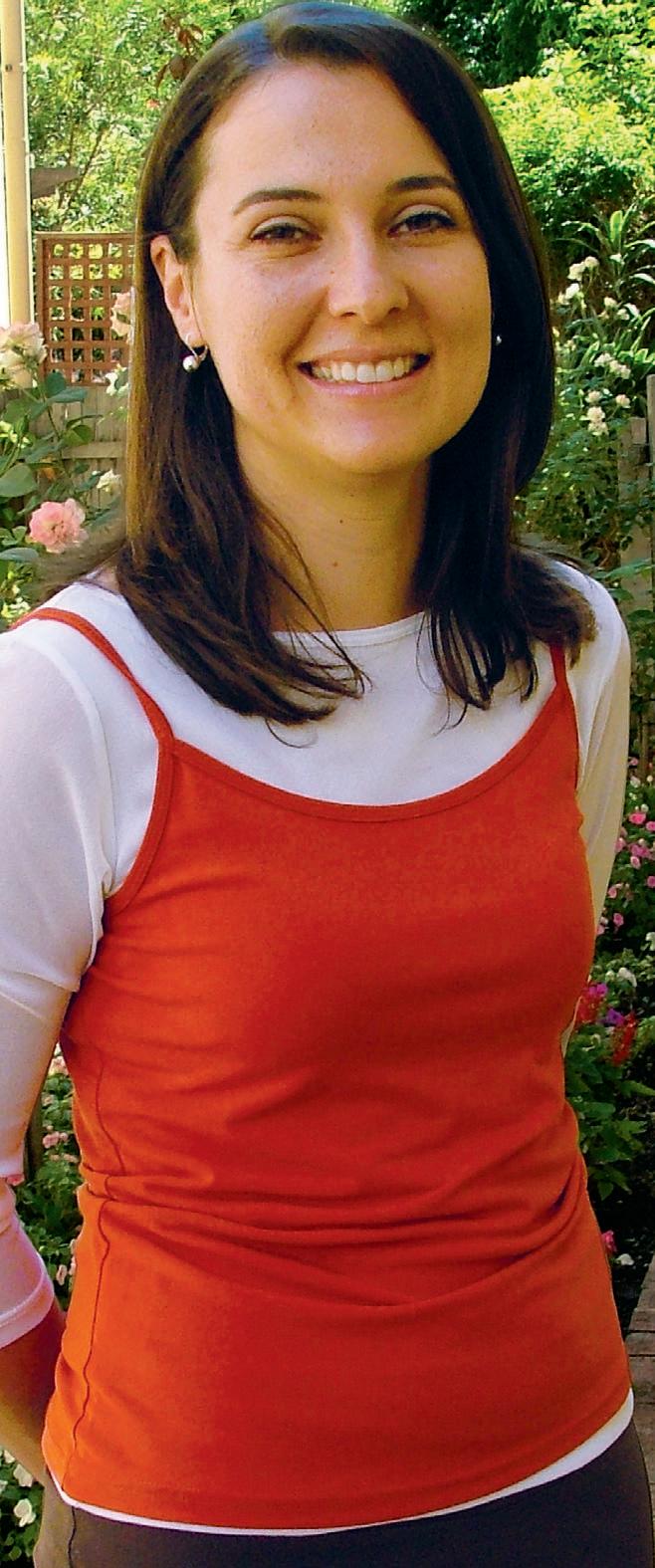
Pre-University Studies
Teaching Assistant
My previous occupation as a bank officer was successful, however spending time at my children's school gave me the inspiration to change careers. As a mature student, I initially felt apprehensive, but after attending the Open Day at Notre Dame I knew that this was the university for me. Notre Dame offers a nurturing environment with great support and pastoral care. The lecturers are extremely professional, enlightening and are accommodating to students in the classes. I have found a sense of belonging due to the University’s welcoming nature, which has been wonderful.
I have now commenced the Bachelor of Education (Early Childhood), as a result of completing the Teaching Assistant course. The transition into the degree course has been very smooth as I have been looked upon as an individual, not as a number. Studying in the city of Fremantle also provides a picturesque, cultural learning environment. I look forward to this vocation and the time I will be spending at the University.
Postgraduate Studies
Master of Theology
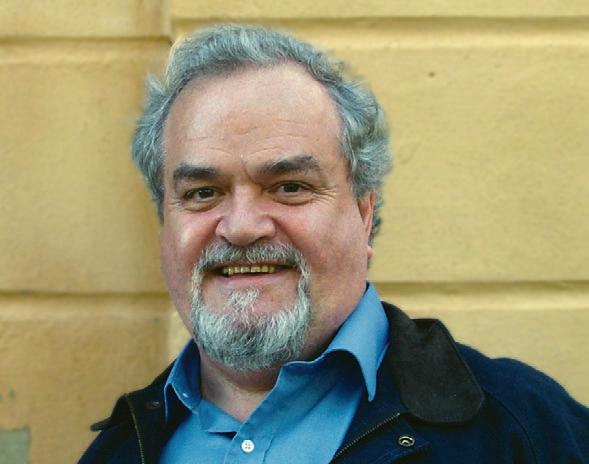
MICHAEL GLOVER
It was at my daughter’s graduation ceremony when I made up my mind to go back to university. I thought “Why should the young have all the fun?”
As a mature age student I feel it is the best time in life to study. At Notre Dame I have learnt that personal development is not something restricted to only one stage of life. After achieving a basic degree in Theology earlier in my career, I have always maintained an interest in the subject. Theology is intellectually stimulating, and deeply challenging as a radical and counter cultural view of the world that we live in.
I like how Theology is taught at Notre Dame as a subject as broad as life itself, yet still focused in itsapplication and scientific in its substance. I also enjoy the experience of coming from a busy job to study at Notre Dame as much for the contact with people of diverse views and backgrounds as for the new insights I gain from it.
Interested in postgraduate studies?
Be sure not to miss our Postgraduate Course Information Evening on
Tuesday 7 November or contact the Prospective Students Office on 9433 0533 for further information.
“ The transition into the course has been very smooth as I am looked upon as an individual, not as a number.
LUCY FERRANTE Graduate Teaching Assistant Certificate (Early Childhood)
FREECALL 1800 640 500 future@nd.edu.au
COURSE INFORMATION EVENINGSDATE VENUE Postgraduate (ALL program areas incl Medicine)
Nov, 6pm startMedicine Lecture Theatre, 38 Henry St Fremantle Broome
Nov, 6pm startFoley Hall, 19 Mouat St Fremantle Medicine
7
28
Dec, 6pm startMedicine Lecture Theatre, 38 Henry St Fremantle
www.nd.edu.au
“
















 ■ By Sylvia Defendi
■ By Sylvia Defendi











































































































